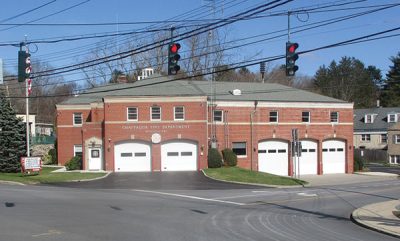Commissioners Concerned New Castle Firehouse Costs May Rise
News Article Article pages that do not meet specifications for other Trust Project Type of Work labels and also do not fit within the general news category.

New Castle fire commissioners are contemplating a referendum late this year that would expand and modernize the King Street firehouse but are concerned that rising interest rates and inflationary pressures will increase the project’s costs.
Commissioners listened to a presentation by the fire district’s architect Bob Mitchell at an Apr. 7 work session where Mitchell said an expanded facility is not only crucial to fit modern apparatus but to provide enough space for proper storage of equipment so it is not in the way of firefighters rushing to a call.
Also vital would be the ability to house equipment that would disinfect gear after firefighters return from a blaze to greatly reduce firefighters’ exposure to carcinogens as well as provide enough space for them to train on-site.
“I know that our architect, Bob Mitchell, has provided us with compelling evidence that the needs and the requirements will force us to make a decision here in the near future regarding putting this forth,” said New Castle Fire District No. 1 Board of Commissioners President Terence Hoey. “There’s no doubt in my mind that this is a critical infrastructure project that’s going to go forward. We can’t delay.”
However, with inflation at its highest levels in 40 years and interest rates poised to rise, commissioners debated whether there should be consideration given to trimming the project. Last December the board provided an estimate of $16,992,906 based on a tentatively scheduled vote that was originally set for Apr. 5.
However, by January, commissioners agreed they could not make key decisions because they were only able to meet virtually as a result of the surge of COVID-19 cases during the Omicron outbreak and didn’t have enough time to conduct sufficient public outreach.
While no date has been mentioned for the referendum, this fall appears to be a feasible goal, the board indicated.
When told by District Treasurer Robin Rizzo at the Apr. 7 work session that a quarter-point rise in interest rates above the 3.25 percent projection used in the December estimate could add about $800,000 to the project, the board questioned whether it would make sense to take another look at the scope of the work.
“If there’s another tick-up in terms of interest rates, we have to run the numbers again. They would need to re-estimate the entire project,” said Commissioner Dwight Smith. “I was just thinking maybe we need to relook at the project in terms of total costs and the reason why I say that is what we see here today.”
Commissioner Brian Murphy said the board could consider holding off on portions of the project that don’t have to be done immediately to demonstrate to the public a fiscally responsible approach.
“The first floor has to be built out completely,” Murphy said. “The second floor, I think we can work with. Maybe hold off on putting bunks in. There’s stuff that we can postpone.”
During his presentation, Mitchell detailed the fire district’s need to have a modernized firehouse, which was first discussed in 2003. The building’s original wing was built in 1954 followed by an expansion in 1979.
Mitchell said in the 1950s, the typical engine measured 279 square feet while one today is about 712 square feet. A modern ladder truck is 912 square feet. The size of the current vehicles requires maintenance and repairs to be performed outside or off-site, he said.
The current station house also provides far less space than the eight-foot separation between trucks that Mitchell Associates Architects, which specializes in firehouse design, builds into its plans, Mitchell said. One community that his firm did work for had a volunteer killed when the firefighter tripped because of inadequate space and was run over by a truck’s wheels while rushing out of the firehouse to a call.
The department’s inability to properly decontaminate equipment and to have access to shower facilities within an hour of returning from a fire poses the greatest risk to firefighters, Mitchell said.
“Firefighter safety and health is a paramount issue, cancer being the number one issue, injuries, sleep deprivation, which some people may be skeptical about in regard to volunteers,” Mitchell said.
He also said the inclusion of bunks are an amenity so some firefighters can stay at the firehouse at certain times or if the district hopes to attract college-age volunteers. In some communities, college students or other volunteers who may not be able to find an affordable place to live reside at the firehouse as part of their service.
Mitchell said the board shouldn’t postpone work thinking prices will decrease in the future. Since 2016, when the previous expansion referendum failed, construction costs have spiked 34 percent, he said.
“The one thing that you can count on is the price is going to go up,” Mitchell said.
Hoey mentioned that he would be opposed to skimping on the project and is optimistic the board can convince the voting public that the work is justified. The board agreed it should hire a public relations professional to help with messaging.
“I think it’s shortsighted to not build an entire building with all of the functional requirements and all the needs in one job,” Hoey said.

Martin has more than 30 years experience covering local news in Westchester and Putnam counties, including a frequent focus on zoning and planning issues. He has been editor-in-chief of The Examiner since its inception in 2007. Read more from Martin’s editor-author bio here. Read Martin’s archived work here: https://www.theexaminernews.com/author/martin-wilbur2007/
